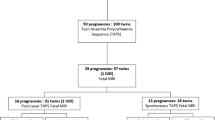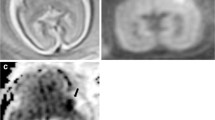Abstract
Objective
Due to the increased risk of antenatal brain lesions, we offer a third-trimester magnetic resonance imaging (MRI) scan to all patients who underwent an in utero intervention for twin-twin transfusion syndrome (TTTS). However, the usefulness of such a policy has not been demonstrated yet. Therefore, we determined the prevalence of antenatal brain lesions detected on third-trimester MRI and the proportion of lesions detected exclusively on MRI.
Materials and methods
We conducted a retrospective cohort study of monochorionic diamniotic twin pregnancies complicated by TTTS that underwent laser coagulation of the vascular anastomoses or fetal reduction by umbilical cord occlusion between 2010 and 2017. We reviewed the third-trimester MRI findings and compared those with the prenatal ultrasonography.
Results
Of the 141 patients treated with laser coagulation and 17 managed by cord occlusion, 112/141 (79%) and 15/17 (88%) patients reached 28 weeks. Of those, 69/112 (62%) and 11/15 (73%) underwent an MRI between 28 and 32 weeks. After laser coagulation, MRI detected an antenatal brain lesion in 6 of 69 pregnancies (9%) or in 6 of 125 fetuses (5%). In 4 cases (67%), the lesion was detected only on MRI. In the 11 patients treated with cord occlusion, no brain lesions were diagnosed.
Conclusion
The prevalence of brain lesions detected by third-trimester MRI is higher compared to prenatal ultrasonography alone, making MRI a useful adjunct to detect antenatal brain lesions in twin pregnancies after in utero treatment for TTTS.
Key Points
• In utero interventions for twin-to-twin transfusion syndrome (TTTS) do not prevent the occurrence of antenatal brain lesions.
• Fetal magnetic resonance imaging (MRI) has high accuracy in detecting anomalies of cortical development and can be a useful adjunct to ultrasonography in diagnosing certain brain abnormalities.
• After laser coagulation of the anastomoses for TTTS, third-trimester MRI diagnosed a brain lesion that was not detected earlier on ultrasound scan in 6% of pregnancies.



Similar content being viewed by others
Abbreviations
- DWI:
-
Diffusion-weighted imaging
- EPI:
-
Echo planar imaging
- GA:
-
Gestational age
- HASTE:
-
Half Fourier acquisition turbo spin echo
- TAPS:
-
Twin anaemia polycythaemia sequence
- TTTS:
-
Twin-twin transfusion syndrome
References
Lewi L, Cannie M, Blickstein I et al (2007) Placental sharing, birthweight discordance, and vascular anastomoses in monochorionic diamniotic twin placentas. Am J Obstet Gynecol 197(587):e581–e588
Lewi L, Jani J, Blickstein I et al (2008) The outcome of monochorionic diamniotic twin gestations in the era of invasive fetal therapy: a prospective cohort study. Am J Obstet Gynecol 199(514):e511–e518
Senat MV, Deprest J, Boulvain M, Paupe A, Winer N, Ville Y (2004) Endoscopic laser surgery versus serial amnioreduction for severe twin-to-twin transfusion syndrome. N Engl J Med 351:136–144
Lewi L, Gratacos E, Ortibus E et al (2006) Pregnancy and infant outcome of 80 consecutive cord coagulations in complicated monochorionic multiple pregnancies. Am J Obstet Gynecol 194:782–789
Lopriore E, van Wezel-Meijler G, Middeldorp JM, Sueters M, Vandenbussche FP, Walther FJ (2006) Incidence, origin, and character of cerebral injury in twin-to-twin transfusion syndrome treated with fetoscopic laser surgery. Am J Obstet Gynecol 194:1215–1220
Sananes N, Gabriele V, Weingertner AS et al (2016) Evaluation of long-term neurodevelopment in twin-twin transfusion syndrome after laser therapy. Prenat Diagn 36:1139–1145
Conte G, Righini A, Griffiths PD et al (2018) Brain-injured survivors of monochorionic twin pregnancies complicated by single intrauterine death: MR findings in a multicenter study. Radiology 288:582–590
Spruijt M, Steggerda S, Rath M et al (2012) Cerebral injury in twin-twin transfusion syndrome treated with fetoscopic laser surgery. Obstet Gynecol 120:15–20
Robinson AJ, Ederies MA (2018) Fetal neuroimaging: an update on technical advances and clinical findings. Pediatr Radiol 48:471–485
Witters I, Cannie M, Fryns JP (2007) Prenatal diagnosis of trisomy 17 mosaicism. Prenat Diagn 27:677–678
Griffiths PD, Bradburn M, Campbell MJ et al (2017) Use of MRI in the diagnosis of fetal brain abnormalities in utero (MERIDIAN): a multicentre, prospective cohort study. Lancet 389:538–546
Jarvis D, Mooney C, Cohen J et al (2017) A systematic review and meta-analysis to determine the contribution of mr imaging to the diagnosis of foetal brain abnormalities in utero. Eur Radiol 27:2367–2380
ENSO Working Group (2020) Role of prenatal magnetic resonance imaging in fetuses with isolated mild or moderate ventriculomegaly in the era of neurosonography: a multicenter study. Ultrasound Obstet Gynecol https://doi.org/10.1002/uog.21974
Quintero RA, Morales WJ, Allen MH, Bornick PW, Johnson PK, Kruger M (1999) Staging of twin-twin transfusion syndrome. J Perinatol 19:550–555
Garel C (2005) Fetal cerebral biometry: normal parenchymal findings and ventricular size. Eur Radiol 15:809–813
Righini A, Parazzini C, Doneda C et al (2012) Early formative stage of human focal cortical gyration anomalies: fetal MRI. AJR Am J Roentgenol 198:439–447
Glenn OA, Norton ME, Goldstein RB, Barkovich AJ (2005) Prenatal diagnosis of polymicrogyria by fetal magnetic resonance imaging in monochorionic cotwin death. J Ultrasound Med 24:711–716
Fogliarini C, Chaumoitre K, Chapon F et al (2005) Assessment of cortical maturation with prenatal MRI: part II: abnormalities of cortical maturation. Eur Radiol 15:1781–1789
Glenn OA, Cuneo AA, Barkovich AJ, Hashemi Z, Bartha AI, Xu D (2012) Malformations of cortical development: diagnostic accuracy of fetal MR imaging. Radiology 263:843–855
Weisz B, Hoffmann C, Ben-Baruch S et al (2014) Early detection by diffusion-weighted sequence magnetic resonance imaging of severe brain lesions after fetoscopic laser coagulation for twin-twin transfusion syndrome. Ultrasound Obstet Gynecol 44:44–49
Righini A, Kustermann A, Parazzini C, Fogliani R, Ceriani F, Triulzi F (2007) Diffusion-weighted magnetic resonance imaging of acute hypoxic-ischemic cerebral lesions in the survivor of a monochorionic twin pregnancy: case report. Ultrasound Obstet Gynecol 29:453–456
Jelin AC, Norton ME, Bartha AI, Fick AL, Glenn OA (2008) Intracranial magnetic resonance imaging findings in the surviving fetus after spontaneous monochorionic cotwin demise. Am J Obstet Gynecol 199(398):e391–e395
Quarello E, Molho M, Ville Y (2007) Incidence, mechanisms, and patterns of fetal cerebral lesions in twin-to-twin transfusion syndrome. J Matern Fetal Neonatal Med 20:589–597
Stirnemann J, Chalouhi G, Essaoui M et al (2016) Fetal brain imaging following laser surgery in twin-to-twin surgery. BJOG 125(9):1186–1191. https://doi.org/10.1111/1471-0528.14162
Hoffmann C, Weisz B, Yinon Y et al (2013) Diffusion MRI findings in monochorionic twin pregnancies after intrauterine fetal death. AJNR Am J Neuroradiol 34:212–216
Paladini D, Malinger G, Pilu G, Timor-Trisch I, Volpe P (2017) The MERIDIAN trial: caution is needed. Lancet 389:2103
Griffiths PD, Mooney C, Bradburn M, Jarvis D (2018) Should we perform in utero MRI on a fetus at increased risk of a brain abnormality if ultrasonography is normal or shows non-specific findings? Clin Radiol 73:123–134
Hoffmann C, Weisz B, Lipitz S et al (2014) Regional apparent diffusion coefficient values in 3rd trimester fetal brain. Neuroradiology 56:561–567
Yaniv G, Hoffmann C, Weisz B et al (2016) Region-specific reductions in brain apparent diffusion coefficient in cytomegalovirus-infected fetuses. Ultrasound Obstet Gynecol 47:600–607
Yaniv G, Katorza E, Bercovitz R et al (2016) Region-specific changes in brain diffusivity in fetal isolated mild ventriculomegaly. Eur Radiol 26:840–848
Tarui T, Khwaja OS, Estroff JA, Robinson JN, Gregas MC, Grant PE (2012) Altered fetal cerebral and cerebellar development in twin-twin transfusion syndrome. AJNR Am J Neuroradiol 33:1121–1126
Funding
This study has received funding by his study was funded by a grant from the Fund for Academic Research of the University Hospitals Leuven, Belgium; LL is the recipient of a grant of “Fonds voor Wetenschappelijk Onderzoek” (FWO grantnr: 1804718N).
Author information
Authors and Affiliations
Corresponding author
Ethics declarations
Guarantor
The scientific guarantor of this publication is Prof. dr. Liesbeth Lewi.
Conflict of interest
The authors of this manuscript declare no relationships with any companies whose products or services may be related to the subject matter of the article.
Statistics and biometry
Two of the authors have significant statistical expertise.
Informed consent
Written informed consent was waived by the Institutional Review Board.
Ethical approval
Institutional Review Board approval was obtained.
Methodology
• retrospective
• observational
• performed at one institution
Additional information
Publisher’s note
Springer Nature remains neutral with regard to jurisdictional claims in published maps and institutional affiliations.
Rights and permissions
About this article
Cite this article
Aertsen, M., Van Tieghem De Ten Berghe, C., Deneckere, S. et al. The prevalence of brain lesions after in utero surgery for twin-to-twin transfusion syndrome on third-trimester MRI: a retrospective cohort study. Eur Radiol 31, 4097–4103 (2021). https://doi.org/10.1007/s00330-020-07452-x
Received:
Revised:
Accepted:
Published:
Issue Date:
DOI: https://doi.org/10.1007/s00330-020-07452-x




